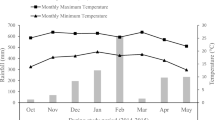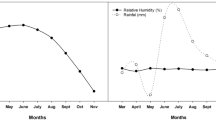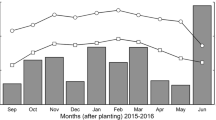Abstract
Purpose
Biochar can improve soil nutrient retention and alleviate salinity; however, use is not widespread due to cost. Biochar is usually co-applied with a full-rate of supplementary fertiliser before planting. This study investigated co-application of bamboo biochar with organic fertiliser and amendments on nutrient cycling, plant growth, yield and commercial value of ginger.
Methods
Four treatments were applied including no amendment, organic amendments and organic amendments co-applied with biochar at two applications rates of 10 t ha−1 and 30 t ha−1. Plant growth, biomass, foliar nutrient and water-extractable soil nutrients were examined.
Results
Co-applied high rate biochar increased available soil potassium (K) concentration (+ 89%) over 22 weeks and led to increased foliar K concentration (+ 25%) at harvest and after 30 weeks compared with organic amendments alone. Biochar high rate decreased soil sodium concentration (− 22%) over 22 weeks. Biochar high rate increased root mass fraction and plant height but decreased the number of stems, and therefore, did not increase aboveground biomass compared with all other treatments. In contrast, ginger rhizome yield, grade and commercial value were not affected by biochar treatments.
Conclusion
Added biochar provided additional net K that improved foliar concentration late in the growing season following dissolution. The additional K supply then stimulated root growth and biomass re-allocation despite daily irrigation throughout the growing season. Therefore, we suggest biochar as a useful amendment to prevent nutrient loss and alleviate salinity for organic crops.






Similar content being viewed by others
References
Akhtar SS, Andersen MN, Liu F (2015) Biochar mitigates salinity stress in potato. J Agron Crop Sci 201:368–378
Asadyar L, Xu CY, Wallace HM, Xu Z, Reverchon F, Bai SH (2020) Soil-plant nitrogen isotope composition and nitrogen cycling after biochar applications. Environ Sci Pollut Res, pp 1–7
Asher CJ, Lee MT (1975) Diagnosis and correction of nutritional disorders in ginger (Zingiber officinale). Department of Agriculture, University of Queensland, Brisbane
Attoe EE, Osodeke VE (2009) Effects of NPK on growth and yield of ginger (Zingiber officinale Roscoe) in soils of contrasting parent materials of cross River State. Elec J Environ Agric Food Chem 8:1261–1268
Bach M, Wilske B, Breuer L (2016) Current economic obstacles to biochar use in agriculture and climate change mitigation. Carbon Manag 7:183–190
Bai SH, Reverchon F, Xu CY, Xu Z, Blumfield TJ, Zhao H, Van Zwieten L, Wallace HM (2015) Wood biochar increases nitrogen retention in field settings mainly through abiotic processes. Soil Biol Biochem 90:232–240
Baiamonte G, De Pasquale C, Marsala V, Cimò G, Alonzo G, Crescimanno G, Conte P (2014) Structure alteration of a sandy-clay soil by biochar amendments. J Soils Sediments 15:816–824
Barker AV, Pilbeam DJ (2015) Handbook of plant nutrition. CRC Press, Boca Raton
Basak B (2019) Waste mica as alternative source of plant-available potassium: evaluation of agronomic potential through chemical and biological methods. Nat Resour Res 28:953–965
Benjamini Y, Hochberg Y (1995) Controlling the false discovery rate: a practical and powerful approach to multiple testing. J Roy Stat Soc Ser B (Method) 57:289–300
Biederman LA, Harpole WS (2013) Biochar and its effects on plant productivity and nutrient cycling: a meta-analysis. GCB Bioenergy 5:202–214
Blum WEH, Schad P, Nortcliff S (2018) Essentials of soil science-soil formation, functions, use and classification (World Reference Base, WRB). CSIRO Publishing, Clayton South
Bornø ML, Müller-Stöver DS, Liu F (2019) Biochar properties and soil type drive the uptake of macro- and micronutrients in maize (Zea mays L.). J Plant Nutr Soil Sci 182:149–158
Brandt M, Hiernaux P, Rasmussen K, Tucker CJ, Wigneron JP, Diouf AA, Herrmann SM, Zhang W, Kergoat L, Mbow C, Abel C, Auda Y, Fensholt R (2019) Changes in rainfall distribution promote woody foliage production in the Sahel. Commun Biol 2:133
Bruun EW, Petersen CT, Hansen E, Holm JK, Hauggaard-Nielsen H (2014) Biochar amendment to coarse sandy subsoil improves root growth and increases water retention. Soil Use Manag 30:109–118
Camacho HE, Brescia A (2009) The Australian ginger industry: overview of market trends and opportunities. The State of Queensland, Department of Employment, Economic Development and Innovation. https://www.daf.qld.gov.au/__data/assets/pdf_file/0006/74895/Australian-ginger-industry-report.pdf. Accessed 1 September 2020
Castellini M, Giglio L, Niedda M, Palumbo AD, Ventrella D (2015) Impact of biochar addition on the physical and hydraulic properties of a clay soil. Soil Tillage Res 154:1–13
Chen Q, Zhang X, Zhang H, Christie P, Li X, Horlacher D, Liebig HP (2004) Evaluation of current fertilizer practice and soil fertility in vegetable production in the Beijing region. Nutr Cycl Agroecosyst 69:51–58
Clarke M (2017) Ginger program RD&E plan 2017–2022. Rural Industries Research and Development Corporation. Wagga Wagga, New South Wales
Coochin Creek Fruit Growers Co-Operative (2019) Fertilisers & chemicals. https://coochincreek.com.au/product-category/fertilisers-chemicals/. Accessed 10 October 2020
Dinesh R, Srinivasan V, Hamza S, Manjusha A, Sanjay Kumar P (2012) Short-term effects of nutrient management regimes on biochemical and microbial properties in soils under rainfed ginger (Zingiber officinale Rosc.). Geoderma 173-174:192–198
Dinno A (2015) Nonparametric pairwise multiple comparisons in independent groups using Dunn’s test. Stata J 15:292–300
Fageria V (2001) Nutrient interactions in crop plants. J Plant Nutr 24:1269–1290
Farhangi-Abriz S, Torabian S (2018) Effect of biochar on growth and ion contents of bean plant under saline condition. Environ Sci Pollut Res 25:11556–11564
Farrar MB, Wallace HM, Xu CY, Nguyen TTN, Tavakkoli E, Joseph S, Bai SH (2019) Short-term effects of organo-mineral enriched biochar fertiliser on ginger yield and nutrient cycling. J Soils Sediments 19:668–682
Gale NV, Thomas SC (2019) Dose-dependence of growth and ecophysiological responses of plants to biochar. Sci Total Environ 658:1344–1354
Gosling P, Shepherd M (2005) Long-term changes in soil fertility in organic arable farming systems in England, with particular reference to phosphorus and potassium. Agric Ecosyst Environ 105:425–432
Green Man Char (2020) Biochar. Green Man Char – Sustainable charcoal & biochar products. https://greenmanchar.com.au/collections/frontpage/products/biochar. Accessed 10 October 2020
Gul S, Whalen JK (2016) Biochemical cycling of nitrogen and phosphorus in biochar-amended soils. Soil Biol Biochem 103:1–15
Haag HP, Saito S, Dechen AR, Carmello QAC (1990) Accumulation of dry matter and uptake of macro-and micro-nutrients by ginger. Anais da Escola Superior de Agriculture ‘'Luiz de Queiroz’ 47:435–457
Halder NK, Shill NC, Siddiky MA, Gomes R, Sarkar J (2007) Response of ginger to zinc and boron fertilization. Asian J Plant Sci 6:394–398
Hazelton P, Murphy B (2016) Interpreting soil test results: what do all the numbers mean? 3rd edn. CSIRO Publishing, Clayton
Hertel TW (2015) The challenges of sustainably feeding a growing planet. Food Secur 7:185–198
Hu Y, Schmidhalter U (2005) Drought and salinity: a comparison of their effects on mineral nutrition of plants. J Plant Nutr Soil Sci 168:541–549
Isbell RF (2016) The Australian soil classification, 2nd edn. CSIRO Publishing, Clayton South
Joseph S, Xu C, Wallace H, Farrar MB, Nguyen TTN, Hosseini Bai S, Solaiman Z (2017) Biochar production from agricultural and forestry wastes and microbial interactions. In: Wong J, Tyagi R, Pandey A (eds) Current developments in biotechnology and bioengineering: solid waste management, 1st edn. Elsevier Inc., Amsterdam, pp 443–473
Lehmann J (2007) Bio-energy in the black. Front Ecol Environ 5:381–387
Lehmann J, Rillig MC, Thies J, Masiello CA, Hockaday WC, Crowley D (2011) Biochar effects on soil biota-a review. Soil Biol Biochem 43:1812–1836
Li Y, Cheng J, Lee X, Chen Y, Gao W, Pan W, Tang Y (2019) Effects of biochar-based fertilizers on nutrient leaching in a tobacco-planting soil. Acta Geochimica 38:1–7
Liang TB, Wang ZL, Wang RJ, Liu LL, Shi CY (2007) Effects of potassium humate on ginger root growth and its active oxygen metabolism. Chin J Appl Ecol 18:813–817
Mehrabi Z (2020) Food system collapse. Nat Clim Chang 10:16–17
Mitra G (2017) Essential plant nutrients and recent concepts about their uptake. In: Naeem M, Ansari AA, Gill SS (eds) Essential plant nutrients. Springer International Publishing AG, Switzerland, pp 3–36
Mueller ND, Gerber JS, Johnston M, Ray DK, Ramankutty N, Foley JA (2012) Closing yield gaps through nutrient and water management. Nat 490:254–257
Nair KP (2013) The agronomy and economy of turmeric and ginger. Elsevier, London
Nguyen TTN, Wallace HM, Xu C-Y, Xu Z, Farrar MB, Joseph S, Van Zwieten L, Bai SH (2017a) Short-term effects of organo-mineral biochar and organic fertilisers on nitrogen cycling, plant photosynthesis, and nitrogen use efficiency. J Soils Sediments 17:2763–2774
Nguyen TTN, Wallace HM, Xu C-Y, Xu Z, Farrar MB, Joseph S, Van Zwieten L, Bai SH (2018a) Comparison of biochar-based amendments on soil plant nitrogen dynamics and nitrogen use efficiency. University of the Sunshine Coast, Australia
Nguyen TTN, Wallace HM, Xu C-Y, Zwieten L, Weng ZH, Xu Z, Che R, Tahmasbian I, Hu H-W, Bai SH (2018b) The effects of short term, long term and reapplication of biochar on soil bacteria. Sci Total Environ 636:142–151
Nguyen TTN, Xu C-Y, Tahmasbian I, Che R, Xu Z, Zhou X, Wallace HM, Bai SH (2017b) Effects of biochar on soil available inorganic nitrogen: a review and meta-analysis. Geoderma 288:79–96
Olmo M, Villar R, Salazar P, Alburquerque JA (2016) Changes in soil nutrient availability explain biochar’s impact on wheat root development. Plant Soil 399:333–343
Oram NJ, van de Voorde TFJ, Ouwehand G-J, Bezemer TM, Mommer L, Jeffery S, Groenigen JWV (2014) Soil amendment with biochar increases the competitive ability of legumes via increased potassium availability. Agric Ecosyst Environ 191:92–98
Pituello C, Francioso O, Simonetti G, Pisi A, Torreggiani A, Berti A, Morari F (2015) Characterization of chemical–physical, structural and morphological properties of biochars from biowastes produced at different temperatures. J Soils Sediments 15:792–804
Purakayastha TJ, Bera T, Bhaduri D, Sarkar B, Mandal S, Wade P, Kumari S, Biswas S, Menon M, Pathak H, Tsang DCW (2019) A review on biochar modulated soil condition improvements and nutrient dynamics concerning crop yields: pathways to climate change mitigation and global food security. Chemosphere 227:345–365
Purakayastha TJ, Das KC, Gaskin J, Harris K, Smith JL, Kumari S (2016) Effect of pyrolysis temperatures on stability and priming effects of C3 and C4 biochars applied to two different soils. Soil Tillage Res 155:107–115
Quilty JR, Cattle SR (2011) Use and understanding of organic amendments in Australian agriculture: a review. Soil Res 49:1–26
R Core Team (2018) R: a language and environment for statistical computing. R Foundation for Statistical Computing, Vienna
Rajkovich S, Enders A, Hanley K, Hyland C, Zimmerman AR, Lehmann J (2012) Corn growth and nitrogen nutrition after additions of biochars with varying properties to a temperate soil. Biol Fertil Soils 48:271–284
Rezaie N, Razzaghi F, Sepaskhah AR (2019) Different levels of irrigation water salinity and biochar influence on faba bean yield, water productivity, and ions uptake. Commun Soil Sci Plant Anal 50:611–626
Robb S, Joseph S, Aziz AA, Dargusch P, Tisdell C (2020) Biochar’s cost constraints are overcome in small-scale farming in tropical soils in lower-income countries. Land Degrad Dev 31:1713–1726
RStudio Team (2016) RStudio: integrated development for R. RStudio. RStudio, Inc., Boston
Saifullah, Dahlawi S, Naeem A, Rengel Z, Naidu R (2018) Biochar application for the remediation of salt-affected soils: challenges and opportunities. Sci Total Environ 625:320–335
Sha Z, Li Q, Lv T, Misselbrook T, Liu X (2019) Response of ammonia volatilization to biochar addition: a meta-analysis. Sci Total Environ 655:1387–1396
Sikder S, Joardar JC (2019) Biochar production from poultry litter as management approach and effects on plant growth. Int J Recycl Org Waste Agric 8:47–58
Smith M, Hamill S (1996) Field evaluation of micropropagated and conventionally propagated ginger in subtropical Queensland. Aust J Exp Agric 36:347–354
Tan Z, Lin CSK, Ji X, Rainey TJ (2017) Returning biochar to fields: a review. Appl Soil Ecol 116:1–11
Tilman D, Balzer C, Hill J, Befort BL (2011) Global food demand and the sustainable intensification of agriculture. Proc Natl Acad Sci U S A 108:20260–20264
Timilsena YP, Adhikari R, Casey P, Muster T, Gill H, Adhikari B (2015) Enhanced efficiency fertilisers: a review of formulation and nutrient release patterns. J Sci Food Agric 95:1131–1142
Vaccari FP, Maienza A, Miglietta F, Baronti S, Di Lonardo S, Giagnoni L, Lagomarsino A, Pozzi A, Pusceddu E, Ranieri R, Valboa G, Genesio L (2015) Biochar stimulates plant growth but not fruit yield of processing tomato in a fertile soil. Agric Ecosyst Environ 207:163–170
Van Zwieten L, Kimber S, Morris S, Chan KY, Downie A, Rust J, Joseph S, Cowie A (2010) Effects of biochar from slow pyrolysis of papermill waste on agronomic performance and soil fertility. Plant Soil 327:235–246
Wakeel A (2013) Potassium–sodium interactions in soil and plant under saline-sodic conditions. J Plant Nutr Soil Sci 176:344–354
Wang L, Xue C, Nie X, Liu Y, Chen F (2018) Effects of biochar application on soil potassium dynamics and crop uptake. J Plant Nutr Soil Sci 181:635–643
Wang S, Zhang H, Huang H, Xiao R, Li R, Zhang Z (2020) Influence of temperature and residence time on characteristics of biochars derived from agricultural residues: a comprehensive evaluation. Process Saf Environ Prot 139:218–229
Wickham H (2016) ggplot2: elegant graphics for data analysis. Springer-Verlag, New York
Xu CY, Bai SH, Hao Y, Rachaputi RCN, Xu Z, Wallace HM (2015) Peanut shell biochar improves soil properties and peanut kernel quality on a red Ferrosol. J Soils Sediments 15:2220–2231
Ye L, Camps-Arbestain M, Shen Q, Lehmann J, Singh B, Sabir M (2020) Biochar effects on crop yields with and without fertilizer: a meta-analysis of field studies using separate controls. Soil Use Manag 36:2–18
Zornoza R, Moreno-Barriga F, Acosta JA, Muñoz MA, Faz A (2016) Stability, nutrient availability and hydrophobicity of biochars derived from manure, crop residues, and municipal solid waste for their use as soil amendments. Chemosphere 144:122–130
Acknowledgements
The authors would like to acknowledge Mr. Scott Byrnes and Mr. Geoffrey Lambert and for assistance with laboratory analysis, Mrs. Emma Farrar, Mr. Bruce Randall, Mr. Ross McIntosh, Mr. Ian Darby, Mr. Chris Taylor, Mrs. April Gray and Dr. David Walton for their valued assistance with field work.
Funding
Mr. Michael B Farrar was supported by University of the Sunshine Coast and received an Australian Government Research Training Program (RTP) Scholarship to undertake this research. This study was supported with Seed Funding from Griffith University and University of the Sunshine Coast.
Author information
Authors and Affiliations
Corresponding author
Additional information
Responsible editor: Weixin Ding
Publisher’s note
Springer Nature remains neutral with regard to jurisdictional claims in published maps and institutional affiliations.
Supplementary information
ESM 1
(DOCX 110 kb)
Rights and permissions
About this article
Cite this article
Farrar, M.B., Wallace, H.M., Xu, CY. et al. Biochar co-applied with organic amendments increased soil-plant potassium and root biomass but not crop yield. J Soils Sediments 21, 784–798 (2021). https://doi.org/10.1007/s11368-020-02846-2
Received:
Accepted:
Published:
Issue Date:
DOI: https://doi.org/10.1007/s11368-020-02846-2




